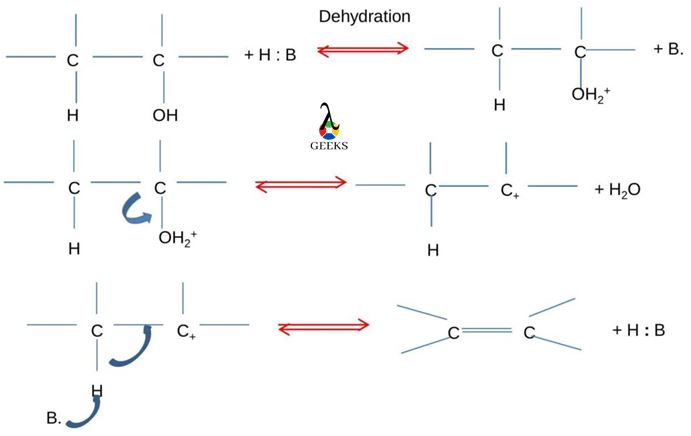Dehydration means the removal of water molecules from anything. The addition or joining or combining of two or more molecules or compounds to form a product by removal of water molecule is known as dehydration reaction or synthesis.
Some of the various dehydration synthesis examples in chemical and biological system.
Explanation of dehydration synthesis
The term dehydration reaction is used both in chemical and biological field as from preparing ethers from alcohols in chemistry or preparing disaccharides (sucrose) in biology. If you want to remember dehydration synthesis then you just remember the words ‘loss or lack of water’.
The dehydration reaction is also referred as condensation reaction, because in condensation reaction also there are two molecules gets condensed to form a large molecule with covalent bonds by removal of by products such as water molecule, or HCl or CH3OH or CH3COOH during the reaction. Both the dehydration and condensation are exact same processes, but water is the most frequent by product of a dehydration or condensation reaction. Let us discuss here both the examples of dehydration synthesis as from chemical field and biological field.
Dehydration synthesis examples in chemical field
Alcohol dehydration
ROH is the general formula for alcohols.
R=alkyl group

OH=hydroxyl group
Alcohols are characterised by the presence of hydroxyl group –OH. Alcohols are classified as primary, secondary and tertiary alcohols. The nomenclatures of alcohols are given by specifying alkyl groups containing hydroxyl group with the word alcohol. Alcohols can form alkenes by dehydration process with elimination of water. Dehydration undergoes with presence of acid and heat applied on it. Alcohol dehydration is carried out in two ways i) heating of alcohols with strong acid like sulphuric or phosphoric acid at high temperature up to 200 degree, ii) at 350-400 degree by passing the alcohol vapors on alumina (Al2O3) which is Lewis acid. The orders of reactivity of alcohol are 3°> 2°> 1°. Here are the examples of dehydration of primary, secondary and tertiary alcohols.

- The mechanism of dehydration is as follows:
- In step 1 of mechanism there is the union of alcohol and hydrogen to form a protonated alcohol.
- In step 2 water and carbonium ion is formed with disassociation of protonated alcohol.
- In step 3 the alkene is formed as final product as the carbonium ion eliminates a hydrogen ion.

Similarly we can see the various examples of dehydration reaction in chemistry like as:
Etherification

Etherification in which the ethers can form, by combining two same or different alcohols by using dehydration reaction.
Esterification
Esterification which involves reaction of carboxylic acid with alcohols to form ester using dehydration reaction, this reaction requires some dehydrating agents to react with water.

Nitrile formation
Nitrile formation in which primary amides gets dehydrated to form nitriles.

Dehydration synthesis examples in biological field
As we already discussed above that the dehydration synthesis or reaction belongs to the formation of large molecule from the small molecules with the loss of water as by products. It is a kind of condensation reaction in which a covalent bond is formed when two functional groups are condensed (joined) with release of water molecule. In bio-system, water is the most recurrent by product of condensation reaction.

ATP-ADP cycle
The most important example of dehydration reaction in biological field is ATP -denosine tri-phosphate and GTP-guanine tri-phosphate formation by the adding high energy phosphate bonds by condensation reaction to nucleosides like A or G i.e. adenosine or guanine, which involves the condensation reaction between adenosine di-phosphate and a phosphate group with hydrolysis of the bond.
Read more on Peptide Bond Formation:How,Why,Where,Exhaustive Facts Around It
Explanation of dehydration synthesis in biological terms:
Dehydration synthesis can be classified on the basis of the reactant, catalyst and products. present in the synthesis. Let’s we discuss about catalytic dehydration reaction. In ether formation or alkene formation the catalyst was hydrogen ion. But in biological living organism’s temperature, pH and salt concentration could not change.
Dehydration synthesis on the basis of catalyst
In living things it is important to have some catalyst to run the reversible reaction in one way. Biological catalysts are known as enzymes and their names are depends on the nature of their catalytic nature. For instance, DNA polymerase is catalytic enzymes which form DNA from deoxy-ribose nucleotides. Glycosylases is the enzyme for formation of protein from carbohydrates. The nomenclature of some enzymes is based on nature of enzyme depends on the way its catalyse the dehydration reaction. The amide bond present in between two amino acids is catalysed by ribosome (peptide bond). As the catalytic region within the ribosome is made mainly of RNA rather than protein, it is also known as an RNA enzyme or ribozyme.
Dehydration synthesis on the basis of reactants
Dehydration synthesis as per reactant used for example, carboxylic acid and amino acid are functional groups present in amino acids attached to same carbon atom. Amine group of one amino acid reacts with acid group of other amino acid which forms amide bond with the elimination of water molecule. The new amino acid formed now contain two functional groups again (dimer) i.e. amine group and carboxylic group to follow the same path of reaction with more amino acids.
Dehydration synthesis on the basis of products
Now, also dehydration reaction can be recognized from the production of its products. As we see in biological system the dehydration reaction mostly produced polymers. Rather these reactions can be recognized based on the formation of complex carbohydrate from simple monosaccharides or from acetyl acetate to produce fatty acids or form proteins from amino acids.
Lastly, the modification of biological molecules like carbohydrates, proteins and nucleosides can be done by dehydration reaction. Examples mainly include that when a carbohydrate and any molecules formed a covalent bond known as glycosidic bonds. The glycosidic bond formed among two glucose molecules when the formation of maltose from glucose is done with the elimination of water molecule. Similarly starch, glycogen or cellulose can be produced depends on position of glycosidic bond by dehydration reaction with long polymers of glucose in same way. Dehydration reaction among two monosaccharides can form other disaccharides like lactose and sucrose.
- 11 Hydrophobic Examples: Facts You Should Know
- Hypotonic Solution: Definition,Examples,Principles,Effects.
- Exergonic vs Endergonic: Detailed Explanations And Insights
- Oganesson Chemical Properties (25 Facts You Should Know)
- 11 Constitutional Isomers Examples: With Detailed Facts
- Discover The 15 Incredible Facts On HNO3 + BeO Reaction

Hello everyone, I am Dr. Shruti M Ramteke, I did my Ph.D. in chemistry. I am passionate about writing and like to share my knowledge with others . Feel free to contact me on linkedin